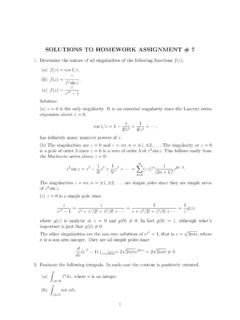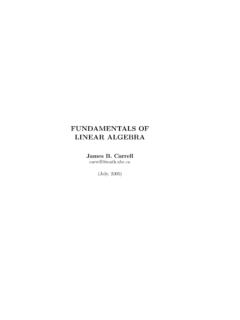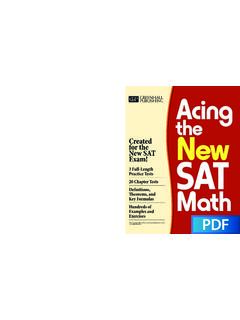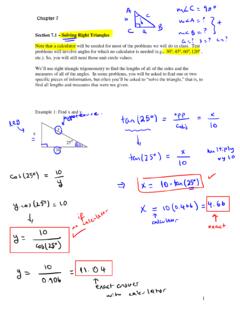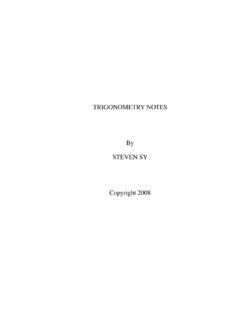Transcription of CLP-2 I
1 CLP-2 I NTEGRAL C ALCULUS. Joel F ELDMAN Andrew R ECHNITZER Elyse Y EAGER. T HIS DOCUMENT WAS TYPESET ON T UESDAY 31 ST A UGUST, 2021. Legal stuff Copyright c 2017 2021 Joel Feldman, Andrew Rechnitzer and Elyse Yeager. This work is licensed under the Creative Commons Attribution-NonCommercial- ShareAlike International License. You can view a copy of the license at Links to the source files can be found at the text webpage 2. C ONTENTS. 1 Integration 1. Definition of the Integral .. 1. Optional A More Rigorous Area Computation .. 9. Summation Notation .. 12. The Definition of the Definite Integral .. 16. Using Known Areas to Evaluate Integrals.
2 23. Another Interpretation for Definite Integrals .. 26. Optional Careful Definition of the Integral .. 27. Basic Properties of the Definite Integral .. 32. More Properties of Integration: Even and Odd Functions .. 40. Optional More Properties of Integration: Inequalities for Integrals 43. The Fundamental Theorem of Calculus .. 45. Substitution .. 60. Area Between Curves .. 74. Volumes .. 85. Integration by Parts .. 99. Trigonometric Integrals .. 109. m Integrating sin x cosn xdx .. 111. Integrating tanm x secn xdx .. 114. Optional integrating sec x, csc x, sec3 x and csc3 x .. 120. Trigonometric Substitution .. 126. Partial Fractions.
3 137. Partial Fraction Decomposition Examples .. 139. The Form of Partial Fraction Decompositions .. 157. Optional Justification of the Partial Fraction Decompositions .. 161. Numerical Integration .. 170. The Midpoint Rule .. 173. The Trapezoidal Rule .. 176. Simpson's Rule .. 179. Three Simple Numerical Integrators Error Behaviour .. 183. Optional An Error Bound for the Midpoint Rule .. 190. i CONTENTS CONTENTS. Improper Integrals .. 192. Definitions .. 192. Examples .. 198. Convergence Tests for Improper Integrals .. 205. 2 Applications of Integration 212. Work .. 212. Averages .. 219. Centre of Mass and Torque .. 230. Centre of Mass.
4 230. Optional Torque .. 238. Separable Differential Equations .. 242. Separate and Integrate .. 243. Optional Carbon Dating .. 248. Optional Newton's Law of Cooling .. 251. Optional Population Growth .. 255. Optional Mixing Problems .. 260. Optional Interest on Investments .. 262. 3 Sequence and Series 266. Sequences .. 267. Series .. 272. Convergence Tests .. 282. The Divergence Test .. 282. The Integral Test .. 284. The Comparison Test .. 290. The Alternating Series Test .. 295. The Ratio Test .. 300. Convergence Test List .. 305. Optional The Leaning Tower of Books .. 305. Optional The Root Test .. 311. Optional Harmonic and Basel Series.
5 314. Optional Some Proofs .. 316. Absolute and Conditional Convergence .. 318. Definitions .. 319. Optional The Delicacy of Conditionally Convergent Series .. 320. Power Series .. 323. Definitions .. 325. Working With Power Series .. 333. Taylor Series .. 340. Extending Taylor Polynomials .. 340. Computing with Taylor Series .. 356. Optional Linking e x with Trigonometric Functions .. 362. Evaluating Limits using Taylor Expansions .. 364. Optional The Big O Notation .. 366. Optional Evaluating Limits Using Taylor Expansions More Ex- amples .. 371. ii CONTENTS CONTENTS. Optional Rational and Irrational Numbers .. 376. A High school material 386.
6 Similar Triangles .. 386. Pythagoras .. 387. Trigonometry Definitions .. 387. Radians, Arcs and Sectors .. 387. Trigonometry Graphs .. 388. Trigonometry Special Triangles .. 388. Trigonometry Simple Identities .. 388. Trigonometry Add and Subtract Angles .. 389. Inverse Trigonometric Functions .. 389. Areas .. 390. Volumes .. 391. Powers .. 391. Logarithms .. 392. Highschool Material You Should be Able to Derive .. 393. Cartesian Coordinates .. 394. Roots of Polynomials .. 395. B Complex Numbers and Exponentials 402. Definition and Basic Operations .. 402. The Complex Exponential .. 406. Definition and Basic Properties.. 406. Relationship with sin and cos.
7 408. Polar Coordinates.. 409. Exploiting Complex Exponentials in Calculus Computations .. 410. Exploiting Complex Exponentials in Differential Equation Compu- tations .. 412. C More About Numerical Integration 418. Richardson Extrapolation .. 418. Romberg Integration .. 421. Adaptive Quadrature .. 423. D Numerical Solution of ODE's 428. Simple ODE Solvers Derivation .. 428. Euler's Method .. 428. The Improved Euler's Method .. 430. The Runge-Kutta Method .. 433. Simple ODE Solvers Error Behaviour .. 435. Local Truncation Error for Euler's Method .. 440. Global Truncation Error for Euler's Method .. 442. Variable Step Size Methods.
8 444. Euler and Euler-2step (preliminary version) .. 445. Euler and Euler-2step (final version) .. 448. Fehlberg's Method .. 451. iii CONTENTS CONTENTS. The Kutta-Merson Process .. 452. The Local Truncation Error for Euler-2step .. 453. iv Chapter 1. I NTEGRATION. Calculus is built on two operations differentiation and integration. Differentiation as we saw last term, differentiation allows us to compute and study the instantaneous rate of change of quantities. At its most basic it allows us to compute tangent lines and velocities, but it also led us to quite sophisticated applications including approximation of functions through Taylor polynomials and optimisation of quantities by studying critical and singular points.
9 Integration at its most basic, allows us to analyse the area under a curve. Of course, its application and importance extend far beyond areas and it plays a central role in solving differential equations. It is not immediately obvious that these two topics are related to each other. However, as we shall see, they are indeed intimately linked. Definition of the Integral Arguably the easiest way to introduce integration is by considering the area between the graph of a given function and the x-axis, between two specific vertical lines such as is shown in the figure above. We'll follow this route by starting with a motivating example.
10 1. I NTEGRATION D EFINITION OF THE I NTEGRAL. A Motivating Example Let us find the area under the curve y = e(x (and above the x axis) for 0 x 1. That is, the area of ( x, y) 0 y e x , 0 x 1 . This area is equal to the definite integral . 1. Area = e x dx 0. Do not worry about this notation or terminology just yet. We discuss it at length below. In different applications this quantity will have different interpretations not just area. For example, if x is time and e x is your velocity at time x, then we'll see later (in Exam- ple ) that the specified area is the net distance travelled between time 0 and time 1. After we finish with the example, we'll mimic it to give a general definition of the integral b a f ( x )dx.)


